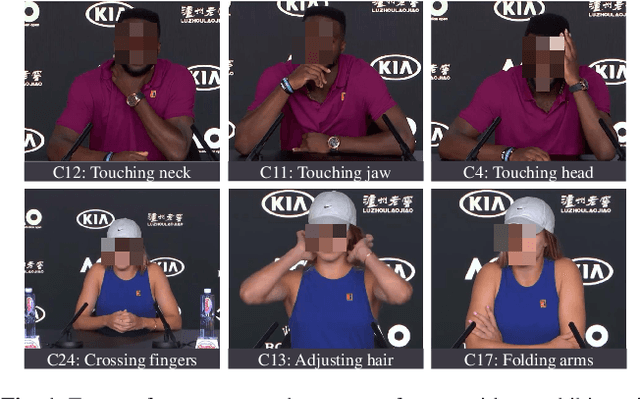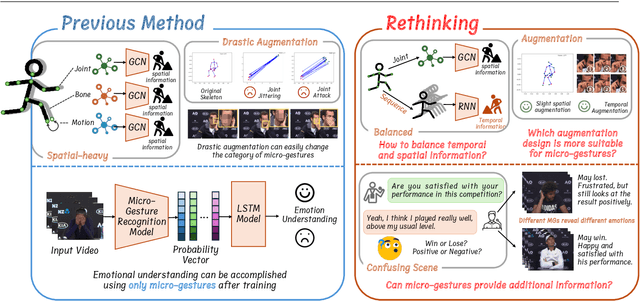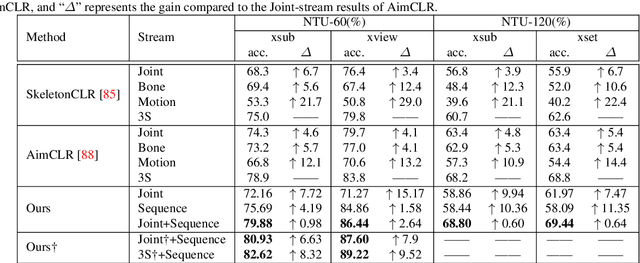Bohao Xing
AU-TTT: Vision Test-Time Training model for Facial Action Unit Detection
Mar 30, 2025Abstract:Facial Action Units (AUs) detection is a cornerstone of objective facial expression analysis and a critical focus in affective computing. Despite its importance, AU detection faces significant challenges, such as the high cost of AU annotation and the limited availability of datasets. These constraints often lead to overfitting in existing methods, resulting in substantial performance degradation when applied across diverse datasets. Addressing these issues is essential for improving the reliability and generalizability of AU detection methods. Moreover, many current approaches leverage Transformers for their effectiveness in long-context modeling, but they are hindered by the quadratic complexity of self-attention. Recently, Test-Time Training (TTT) layers have emerged as a promising solution for long-sequence modeling. Additionally, TTT applies self-supervised learning for iterative updates during both training and inference, offering a potential pathway to mitigate the generalization challenges inherent in AU detection tasks. In this paper, we propose a novel vision backbone tailored for AU detection, incorporating bidirectional TTT blocks, named AU-TTT. Our approach introduces TTT Linear to the AU detection task and optimizes image scanning mechanisms for enhanced performance. Additionally, we design an AU-specific Region of Interest (RoI) scanning mechanism to capture fine-grained facial features critical for AU detection. Experimental results demonstrate that our method achieves competitive performance in both within-domain and cross-domain scenarios.
scFusionTTT: Single-cell transcriptomics and proteomics fusion with Test-Time Training layers
Oct 17, 2024Abstract:Single-cell multi-omics (scMulti-omics) refers to the paired multimodal data, such as Cellular Indexing of Transcriptomes and Epitopes by Sequencing (CITE-seq), where the regulation of each cell was measured from different modalities, i.e. genes and proteins. scMulti-omics can reveal heterogeneity inside tumors and understand the distinct genetic properties of diverse cell types, which is crucial to targeted therapy. Currently, deep learning methods based on attention structures in the bioinformatics area face two challenges. The first challenge is the vast number of genes in a single cell. Traditional attention-based modules struggled to effectively leverage all gene information due to their limited capacity for long-context learning and high-complexity computing. The second challenge is that genes in the human genome are ordered and influence each other's expression. Most of the methods ignored this sequential information. The recently introduced Test-Time Training (TTT) layer is a novel sequence modeling approach, particularly suitable for handling long contexts like genomics data because TTT layer is a linear complexity sequence modeling structure and is better suited to data with sequential relationships. In this paper, we propose scFusionTTT, a novel method for Single-Cell multimodal omics Fusion with TTT-based masked autoencoder. Of note, we combine the order information of genes and proteins in the human genome with the TTT layer, fuse multimodal omics, and enhance unimodal omics analysis. Finally, the model employs a three-stage training strategy, which yielded the best performance across most metrics in four multimodal omics datasets and four unimodal omics datasets, demonstrating the superior performance of our model. The dataset and code will be available on https://github.com/DM0815/scFusionTTT.
EMO-LLaMA: Enhancing Facial Emotion Understanding with Instruction Tuning
Aug 21, 2024



Abstract:Facial expression recognition (FER) is an important research topic in emotional artificial intelligence. In recent decades, researchers have made remarkable progress. However, current FER paradigms face challenges in generalization, lack semantic information aligned with natural language, and struggle to process both images and videos within a unified framework, making their application in multimodal emotion understanding and human-computer interaction difficult. Multimodal Large Language Models (MLLMs) have recently achieved success, offering advantages in addressing these issues and potentially overcoming the limitations of current FER paradigms. However, directly applying pre-trained MLLMs to FER still faces several challenges. Our zero-shot evaluations of existing open-source MLLMs on FER indicate a significant performance gap compared to GPT-4V and current supervised state-of-the-art (SOTA) methods. In this paper, we aim to enhance MLLMs' capabilities in understanding facial expressions. We first generate instruction data for five FER datasets with Gemini. We then propose a novel MLLM, named EMO-LLaMA, which incorporates facial priors from a pretrained facial analysis network to enhance human facial information. Specifically, we design a Face Info Mining module to extract both global and local facial information. Additionally, we utilize a handcrafted prompt to introduce age-gender-race attributes, considering the emotional differences across different human groups. Extensive experiments show that EMO-LLaMA achieves SOTA-comparable or competitive results across both static and dynamic FER datasets. The instruction dataset and code are available at https://github.com/xxtars/EMO-LLaMA.
Identity-free Artificial Emotional Intelligence via Micro-Gesture Understanding
May 21, 2024



Abstract:In this work, we focus on a special group of human body language -- the micro-gesture (MG), which differs from the range of ordinary illustrative gestures in that they are not intentional behaviors performed to convey information to others, but rather unintentional behaviors driven by inner feelings. This characteristic introduces two novel challenges regarding micro-gestures that are worth rethinking. The first is whether strategies designed for other action recognition are entirely applicable to micro-gestures. The second is whether micro-gestures, as supplementary data, can provide additional insights for emotional understanding. In recognizing micro-gestures, we explored various augmentation strategies that take into account the subtle spatial and brief temporal characteristics of micro-gestures, often accompanied by repetitiveness, to determine more suitable augmentation methods. Considering the significance of temporal domain information for micro-gestures, we introduce a simple and efficient plug-and-play spatiotemporal balancing fusion method. We not only studied our method on the considered micro-gesture dataset but also conducted experiments on mainstream action datasets. The results show that our approach performs well in micro-gesture recognition and on other datasets, achieving state-of-the-art performance compared to previous micro-gesture recognition methods. For emotional understanding based on micro-gestures, we construct complex emotional reasoning scenarios. Our evaluation, conducted with large language models, shows that micro-gestures play a significant and positive role in enhancing comprehensive emotional understanding. The scenarios we developed can be extended to other micro-gesture-based tasks such as deception detection and interviews. We confirm that our new insights contribute to advancing research in micro-gesture and emotional artificial intelligence.
Enhancing Micro Gesture Recognition for Emotion Understanding via Context-aware Visual-Text Contrastive Learning
May 03, 2024Abstract:Psychological studies have shown that Micro Gestures (MG) are closely linked to human emotions. MG-based emotion understanding has attracted much attention because it allows for emotion understanding through nonverbal body gestures without relying on identity information (e.g., facial and electrocardiogram data). Therefore, it is essential to recognize MG effectively for advanced emotion understanding. However, existing Micro Gesture Recognition (MGR) methods utilize only a single modality (e.g., RGB or skeleton) while overlooking crucial textual information. In this letter, we propose a simple but effective visual-text contrastive learning solution that utilizes text information for MGR. In addition, instead of using handcrafted prompts for visual-text contrastive learning, we propose a novel module called Adaptive prompting to generate context-aware prompts. The experimental results show that the proposed method achieves state-of-the-art performance on two public datasets. Furthermore, based on an empirical study utilizing the results of MGR for emotion understanding, we demonstrate that using the textual results of MGR significantly improves performance by 6%+ compared to directly using video as input.
* accepted by IEEE Signal Processing Letters
EALD-MLLM: Emotion Analysis in Long-sequential and De-identity videos with Multi-modal Large Language Model
May 01, 2024Abstract:Emotion AI is the ability of computers to understand human emotional states. Existing works have achieved promising progress, but two limitations remain to be solved: 1) Previous studies have been more focused on short sequential video emotion analysis while overlooking long sequential video. However, the emotions in short sequential videos only reflect instantaneous emotions, which may be deliberately guided or hidden. In contrast, long sequential videos can reveal authentic emotions; 2) Previous studies commonly utilize various signals such as facial, speech, and even sensitive biological signals (e.g., electrocardiogram). However, due to the increasing demand for privacy, developing Emotion AI without relying on sensitive signals is becoming important. To address the aforementioned limitations, in this paper, we construct a dataset for Emotion Analysis in Long-sequential and De-identity videos called EALD by collecting and processing the sequences of athletes' post-match interviews. In addition to providing annotations of the overall emotional state of each video, we also provide the Non-Facial Body Language (NFBL) annotations for each player. NFBL is an inner-driven emotional expression and can serve as an identity-free clue to understanding the emotional state. Moreover, we provide a simple but effective baseline for further research. More precisely, we evaluate the Multimodal Large Language Models (MLLMs) with de-identification signals (e.g., visual, speech, and NFBLs) to perform emotion analysis. Our experimental results demonstrate that: 1) MLLMs can achieve comparable, even better performance than the supervised single-modal models, even in a zero-shot scenario; 2) NFBL is an important cue in long sequential emotion analysis. EALD will be available on the open-source platform.
 Add to Chrome
Add to Chrome Add to Firefox
Add to Firefox Add to Edge
Add to Edge